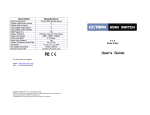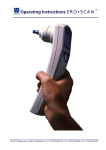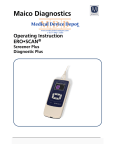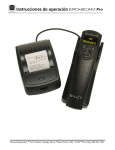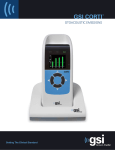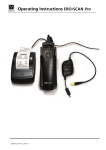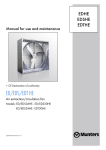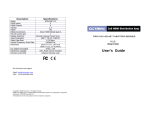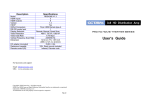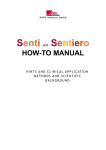Download Operating Instructions
Transcript
Operating Instructions MAICO EROSCAN™ SCREENER Operating Instructions EROSCANTM Screener Table of Contents 1 Introduction ............................................................................................ 1 2 Important Safety Instructions ................................................................... 2 3 Purpose .................................................................................................. 5 4 Description ............................................................................................. 7 5 Setup ...................................................................................................... 9 5.1. Unpacking the System...................................................................... 9 5.2. Connection to the optional Printer ................................................. 10 5.3. Environmental conditions ............................................................... 11 5.4 Battery Installation .......................................................................... 11 5.5 Loading Paper into the optional Printer ............................................ 12 5.6 Attaching Eartips ............................................................................ 13 6 Quick Start ............................................................................................ 14 7 Performing DPOAE and TEOAE Tests...................................................... 15 7.1. Preparing the Patient for Testing .................................................... 15 7.2. Control Buttons ............................................................................. 15 7.3. Turning on the Instrument ............................................................. 15 7.4. Testing in the Default Modes.......................................................... 16 7.4.1 To Begin Testing ....................................................................... 17 7.4.2. Testing children with PE Tubes .................................................. 18 7.4.3 Auto Calibration ....................................................................... 18 7.4.4 Reviewing Results ...................................................................... 19 7.4.5 Test Technique .......................................................................... 19 7.5 Remote Probe (optional).................................................................. 20 7.5.1 Installing the Remote Probe ....................................................... 20 7.5.2 Testing with the Remote Probe .................................................. 22 7.6 Noise Sources ................................................................................. 22 7.7 Printing the Results (optional) .......................................................... 23 GebaEroscreenE_12a.doc 851 983/8 01/12 Operating Instructions EROSCANTM Screener 7.8 Setting the Clock ............................................................................ 24 8 Changing Instrument Settings ............................................................... 26 9 Interpreting Results ............................................................................... 30 10 Cleaning and Maintenance .................................................................. 34 10.1 Probe Tip Replacement.................................................................. 34 11 Troubleshooting .................................................................................. 36 12 Replacement Parts ............................................................................... 37 13 Technical Data .................................................................................... 38 14 Warranty, Maintenance and Service ..................................................... 40 15 Safety Regulations ............................................................................... 41 Appendix A Internal Probe Specifications .................................................. 43 Appendix A Remote Probe Specifications .................................................. 44 Appendix B Program Flowchart................................................................. 45 Appendix B Program Flowchart................................................................. 46 Appendix C Test Sequence ....................................................................... 47 Appendix D Pass/Refer Criteria for DPOAE ................................................ 48 Appendix D Pass/Refer Criteria for TEOAE ................................................. 50 Appendix E Preset Test Protocols .............................................................. 52 Appendix F Testing at 4 kHz ..................................................................... 53 GebaEroscreenE_12a.doc 851 983/8 01/12 Operating Instructions EROSCANTM Screener This manual applies to firmware version 7.67 and higher. 1 Introduction Thank you very much for purchasing a quality product from the MAICO family. This automatic OAE-test system MAICO ERO•SCAN™ Screener is manufactured to meet all quality and safety requirements, and has been certified with the CE-symbol according to Medical Directive 93/42/EEC. In designing the MAICO ERO•SCAN™ Screener we placed particular importance in making it a user-friendly device, meaning its operation is simple and easy to understand. And because all functions are software controlled, upgrading later to new, extended measurement functions will be simple and inexpensive. That means that you have invested in a device that will adjust to your future needs. This user manual should make it as easy as possible for you to become familiar with the functions of the MAICO ERO•SCAN™ Screener. Please open out the flap of illustrations on the last page. The description of the position (e.g.) of controls, displays and connections, found again in the text, will make it easier for you to learn how to operate the MAICO ERO•SCAN™ Screener. If you have problems or have ideas for further improvements, please get in touch with us. Simply call. Your MAICO-Team GebaEroscreenE_12a.doc 1 851 983/8 01/12 Operating Instructions EROSCANTM Screener 2 Important Safety Instructions The MAICO ERO•SCAN™ Screener Otoacoustic Emission Test System should be used only by those individuals trained to perform the testing for which it has been designed. No person should attempt to use this instrument without the necessary knowledge and training to understand how this equipment is to be properly utilized and interpreted. The ERO•SCAN™ Screener Instrument probe tip must not be inserted into an ear at any time without a disposable eartip properly affixed. Precautions READ THIS ENTIRE MANUAL BEFORE ATTEMPTING TO USE THIS SYSTEM. Use this device only as described in this manual. Use only the disposable eartips designed for use with this instrument. Never insert the probe tip into the ear canal without affixing an eartip. The eartips are disposable and for single patient use only. Do not clean or reuse eartips. Use only disposable 1.5v AA/UM-3/R6 Alkaline batteries for the test instrument. Do not use rechargeable cells in this device; do not mix battery types and do not mix old and new batteries. Remove the batteries from the instrument if it will not be used for 4 weeks or more. Do not immerse the unit in any fluids. See the Cleaning section of this manual for proper cleaning procedures. Do not drop or otherwise cause undue impact to this device. If the instrument is dropped or otherwise damaged, return it to the manufacturer for repair and/or calibration. Do not use the instrument if any damage is suspected. Use and store the instrument indoors only. Do not use this instrument or its accessories in temperatures below 40°F (4°C) or above 100°F (38°C), or in relative humidity of more than 90%. Do not attempt to open or service the instrument. Return the instrument to the manufacturer for all service. Opening the instrument case will void the warranty. Do not operate the printer if the power supply has a damaged cord or plug. See the instructions on the following page. Do not expose the printed results to sunlight or heat. Printing on thermal paper fades with exposure to light or heat. Photocopies of test results should be made if the records are to be kept indefinitely. GebaEroscreenE_12a.doc 2 851 983/8 01/12 Operating Instructions EROSCANTM Screener Disclaimer The MAICO ERO•SCAN™ Screener Test Instrument is designed to be a screening device for hearing loss. Sensitivity and specificity of this type of device are based on the test characteristics defined by the user, and may vary depending on environmental and operating conditions. The presence of otoacoustic emissions suggests normal outer hair cell function, which in turn correlates to normal hearing. However, a passing result using this instrument is not an indication that the full auditory system is normal. Thus, a PASS result should not be allowed to override other indications that hearing is not normal. A full audiologic evaluation should be administered if concerns about hearing sensitivity persist. A REFER test result should not be assumed to be an indicator of a lack of auditory function; however, it should be followed with full audiologic diagnostic testing. NOTICE: Under certain circumstances, especially in low-humidity environments, common electrostatic discharge may cause this instrument to turn itself off. This effect causes no permanent damage, and the instrument may be turned on again by the normal procedure of holding the DOWN button. GebaEroscreenE_12a.doc 3 851 983/8 01/12 Operating Instructions EROSCANTM Screener READ THIS SECTION CAREFULLY BEFORE USE Printer AC Power Source Precautions The printer AC power source converts main voltage (120V AC or 230V AC) to a low voltage (12V DC) for powering the printer. Use only the power source supplied for this purpose. This product is for indoor use only. Do not expose to water or excessive dust. This product is not suitable for operation in the presence of flammable anesthetic mixture with air or with nitrous oxide. Do not cover the power source body as it may result in excessive heating. The power source operates when the plug is inserted into an outlet. To turn it off, remove the plug from the outlet. The outlet must be easily accessible and located near the printer. Should a faulty condition occur, remove the plug from the outlet immediately. High Voltage Inside! Do not remove the power supply cover! All service or maintenance must be done by trained personnel. Return the power supply to the manufacturer for service. Cleaning and Disinfecting the Unit Wipe the surface with a cloth slightly dampened with mild detergent or normal hospital bactericides. Do not immerse the unit. Do not clean the unit with isopropyl alcohol or other solvents. Optional Printer Rechargeable Battery Precautions Do not attempt to open the battery pack. The printer battery pack contains NiMh cells. Cadmium is a potentially toxic heavy metal, and exposing the cells increases the risk of leakage or short-circuiting. Do not short circuit the battery contacts. This could cause burns or a fire. Disconnect the printer power supply before removing or replacing the battery pack. Observe local regulations for handling, transport, and disposal of Ni-Mh cells. Regulations in many areas prohibit the disposal of Nickel-Cadmium cells. Complete battery packs may be returned to the manufacturer for recycling. The battery pack must be charged for a minimum of five hours before using the printer for the first time. Failure to fully charge the battery pack before use may reduce the life of the battery pack. GebaEroscreenE_12a.doc 4 851 983/8 01/12 Operating Instructions EROSCANTM Screener 3 Purpose The purpose of the ERO•SCAN™ Screener test system is to provide a rapid measurement and documentation of Distortion Product Otoacoustic Emissions (DPOAEs) or Transient Evoked Otoacoustic Emissions (TEOAEs) at several frequencies. What Are DPOAEs? Distortion Product Otoacoustic Emissions (DPOAEs) are acoustic signals that can be detected in the ear canal of a person with normal outer hair cell function, subsequent to stimulation of the auditory system with a pair of pure tones at frequencies f1 and f2. The resulting emission of interest is the distortion product tone at the frequency 2f1-f2. What Are TEOAEs? Transient Evoked Otoacoustic Emissions (TEOAEs) are acoustic signals that can be detected in the ear canal of a person with normal outer hair cell function, subsequent to stimulation of the auditory system with a series of wideband clicks. What Do Otoacoustic Emissions Results Tell Us? Available evidence suggests that otoacoustic emissions (OAEs) are generated by the cochlea’s outer hair cells, and that the presence of OAEs is an indication that the outer hair cells are normal. Although OAE test data provide no indication of inner hair cell function, or of hearing ability, current research indicates that the majority of hearing-impaired individuals will be identified by a simple OAE test. Patients who fail to generate OAEs should be rescreened and/or referred for additional audiological testing. How Does the ERO•SCAN SCREENER Device Measure DPOAEs? The ERO•SCAN SCREENER instrument generates a series of test tones, directs them into the ear canal, and then measures the level of the DPOAE tone generated by the cochlea. By using different test frequencies, the ERO•SCAN™ Screener device provides an estimate of outer hair cell function over a wide range of frequencies. How Does the ERO•SCAN™ Screener Device Measure TEOAEs? The ERO•SCAN™ Screener instrument generates a series of clicks, directs them into the ear canal, and then analyzes the spectrum of the returning signal, separating the noise and emission. By using bandpass filters, the ERO•SCAN™ Screener device provides an estimate of outer hair cell function over a wide range of frequencies. GebaEroscreenE_12a.doc 5 851 983/8 01/12 Operating Instructions EROSCANTM Screener How Does the ERO•SCAN™ Screener Device Work? The digital signal processor in the instrument generates two pure tones (f 1 and f2) for DPOAEs or a series of wideband clicks for TEOAEs through a digital-toanalog converter. These tones or clicks are presented to the ear via speaker tubes located in the probe. A microphone in the probe measures the sound in the ear canal and transmits the signal to the analog-to-digital converter. The digital signal processor then uses Fast-Fourier Transforms (FFTs) to filter the signal into narrow frequency bands, and detects any emissions present. The level of these emissions can be compared with the level of the noise. The SPL and frequencies of the test tones and the averaging time used to process the signals can be determined by the tester through adjustable settings maintained in static memory within the ERO•SCAN™ Screener instrument. What Frequency Range of Hearing is Estimated? DPOAEs: Approximately 1 kHz to 12 kHz (depending on the frequency range selected). Since the health of the hair cells in the region of the f2 test frequency are estimated, and a) the 2f1-f2 emission frequency is at about sixtenths of the f2 frequency, b) emissions tend to be weak below 600 Hz or so, and c) the ambient noise tends to be highest at low frequencies, the lowest f2 test frequency that can be routinely measured is about 1 kHz. TEOAEs: Roughly 500 Hz to 4 kHz. TEOAEs can be reliably recorded at lower frequencies than DPOAEs, but cannot be measured reliably above 4 kHz. GebaEroscreenE_12a.doc 6 851 983/8 01/12 Operating Instructions EROSCANTM Screener 4 Description What is the ERO•SCAN™ Screener? The ERO•SCAN™ Screener Otoacoustic Emission test instrument is a handheld device designed to provide an objective test of outer hair cell function through the measurement of Distortion Product Otoacoustic Emissions (DPOAEs) or Transient Evoked Otoacoustic Emissions (TEOAEs). Versions with either DPOAEs or TEOAEs or a combined instrument with both methodes are available. The ERO•SCAN™ Screener consists of the hand-held unit, printer, single-use eartips and other accessories. The ERO•SCAN™ Screener instrument may be used as a screening tool, or in conjunction with conventional tests as part of a full audiological evaluation. The ERO•SCAN™ Screener instrument contains the hardware and software for generating the test tones, measuring and displaying the DPOAEs or TEOAEs, and storing the results until they are printed. The plastic housing contains circuit boards that provide the signal processing and display the test results. The instrument also contains four A/UM-3/R6 alkaline batteries to power the device. The instrument uses a liquid-crystal display (LCD) and three lightemitting diodes (LEDs) to provide a visual display of test data and test conditions to the operator. The probe section of the instrument houses a microphone and two speaker tubes which produce test stimuli and measure the sound pressure level (SPL) present in the sealed ear canal. Interface of the instrument to the ear canal is accomplished through disposable eartips made of industrial elastomer, which fit onto the probe tip. The disposable eartips are colour coded to facilitate easy selection by size. Four membrane-type push buttons located on the keypad of the device allow the user to control testing and printing, and to reset test protocols. Printing will commence upon placement of the instrument into the cradle. In the default test mode, the ERO•SCAN™ Screener instrument will store the results from one patient (left and right ear) in its non-volatile memory for subsequent printing. However, the ERO•SCAN™ Screener instrument can store up to 50 test results. The results are displayed via the LCD on the front of the device and are stored in the device’s internal memory. After testing is completed, results can be printed using the printer and/or exported to a computer. Test results are stored in the non-volatile memory so the operator can delay printing until a later time if desired. PC-Interface: A serial RS 232C interface for data transfer to a connected computer is built in. A program for Windows is available as accessory. GebaEroscreenE_12a.doc 7 851 983/8 01/12 Operating Instructions EROSCANTM Screener How are the Results Stored and Reported? When the ERO•SCAN™ Screener is set in its default settings, the instrument will store the results from one patient (left and right ear) in its non-volatile memory for subsequent printing. However, the ERO•SCAN SCREENER instrument can store up to 50 test results. The results are displayed via the LCD on the front of the device and are stored in the device’s internal memory. LEDs Probe tip Display Keypad Eartip Probe Battery Drawer (underneath) Power On Green Button LED Cradle Headphone Jack Figure 1 After testing is completed, results can be printed using the printer and/or exported to a computer. Test results are stored in the non-volatile memory so the operator can delay printing until a later time if desired. GebaEroscreenE_12a.doc 8 851 983/8 01/12 Operating Instructions EROSCANTM Screener 5 Setup 5.1. Unpacking the System Your MAICO ERO•SCANTM Screener is carefully inspected and packed for shipping. However, it is a good practice to thoroughly inspect the outside of the shipping box for signs of damage. If any damage is noted, please notify the carrier immediately. Carefully remove the instrument from the shipping box. Remove the plastic bags and inspect the parts for any damage. Notify the carrier immediately if any mechanical damage is noted. This will assure that a proper claim is made. Save all packing material so the claim adjuster can inspect it as well. Notify your dealer or MAICO when the adjuster has completed the inspection. SAVE ALL THE ORIGINAL PACKING MATERIAL AND THE SHIPPING CONTAINER SO THE INSTRUMENT CAN BE PROPERLY PACKED IF IT NEEDS TO BE RETURNED FOR SERVICE OR CALIBRATION. Please check that all accessories listed below are received in good condition. If any accessories are missing or damaged, immediately notify your dealer or MAICO. Standard accessories: (1) ERO•SCANTM Screener Hand-held Unit (1) Cradle (1) External mini probe (1) Box of 80 Eartips (4 sizes) (4) Probe Tips for internal probe (4) Probe Tips for external probe (4) AA/UM-3/R6 Alkaline Batteries (already installed) ERO SCAN Screener (1) Operating instruction manual Cradle Probe Tips External mini probe Eartips Figure 2 GebaEroscreenE_12a.doc 9 851 983/8 01/12 Operating Instructions EROSCANTM Screener 5.2. Connection to the optional Printer Connect one end of the printer cable ➅into the port ♦ located on the underside of the cradle as shown in Figure 4 to the right. After firmly pushing the broad connector end into place, turn the screws on either side to tighten it. Insert the cable (battery option two cables into the slot ♥ provided on the bottom of the cradle. Return the cradle to right side up. The other end of the cable ➅should be plugged firmly into the inlet at the rear of the printer ➄ . The flat side on the small connector (look for the arrow) goes to the bottom of the printer. The cover of the connector will slide back to ease installation of the connector. Plug the power supply cord into the power supply and into an electrical wall outlet. The printer indicator light ➀(located on the front of the printer) will shine steady green. If you have the optional printer with rechargeable batteries plug the additional short end ➆of the cable ➅ into the external printer power supply. Plug the power supply cord into an electrical outlet. If you use the printer only with batteries (option) the printer indicator light ➀ (located on the front of the printer) will blink green. The recharging time for the batteries is at least 5 hours. See the precautions for the batteries and printer power supply at chapter 2. NOTE for the printer with Ni-Mh rechargeable battery pack: The printer will not run from the power supply, the power supply only charges the battery pack. The battery pack must be charged for a minimum of five hours before using the printer for the first time. The printer will not function without a charged battery pack attached. Failure to fully charge the battery pack before use may reduce the life of the battery pack. L H I J B I C Figure 3 Installation Printer cable GebaEroscreenE_12a.doc J K B C Figure 4 Installation (Option) 10 printer cable 851 983/8 01/12 Operating Instructions EROSCANTM Screener 5.3. Environmental conditions The MAICO ERO•SCANTM Screener should be operated in a quiet room, so that the examinations are not influenced by outside noises. Electro-medical instruments, which emit strong electromagnetic fields (e.g. microwaves - radiotherapy devices), can influence the function of the MAICO ERO•SCANTM Screener. Therefore the use of these instruments is not allowed in close proximity to the ERO•SCANTM Screener. The test room must be at normal temperature, usually 15°C / 59°F to 35°C / 95°F, to guarantee precise measuring results. If the device has been cooled down (e.g. during transport), please wait until it has warmed up. 5.4 Battery Installation The ERO•SCANTM Screener instrument uses 4 AA/UM-3/R6 Alkaline batteries. Open the battery compartment by sliding the battery panel down and install the batteries as indicated on the battery label. Once the batteries are correctly in place, slide the panel back onto its tracks to close the battery compartment. GebaEroscreenE_12a.doc 11 851 983/8 01/12 Operating Instructions EROSCANTM Screener 5.5 Loading Paper into the optional Printer Open the cover of the printer by pulling up and back. Orient the paper roll so that the paper will feed from the bottom of the roll (see Figures 5 and 6). Place the roll of paper into the printer by holding the white paper-holder lever back against the case. Allow the lever to slide back so that it fits onto the hub on the paper roll. The paper roll should move freely on the hub. Pull the green paper-roller release lever forward until it snaps in place to disengage the roller. Slide the end of the paper under the roller; it will come out from the front of the roller. Pull the paper end through the roller until it extends about 3 inches above the roller. Push the paper-release lever back. Push the green button on the top of the printer to advance the paper. The printer indicator light on the front of the printer will now flash green if the paper was properly installed. Pressing the green button twice rapidly will print a test run. Paper release lever Paper holder lever Figure 5 Figure 6 GebaEroscreenE_12a.doc 12 851 983/8 01/12 Operating Instructions EROSCANTM Screener 5.6 Attaching Eartips The ERO•SCANTM Screener instrument comes with a box of disposable eartips that fit a variety of ear canal sizes. The probe tip must have an eartip attached before inserting it into an ear canal. The eartip kit has 12 different size eartips that are color-coded for easy selection. The determination of the appropriate eartip size should be made by persons with proper training and experience. The eartip must seal the ear canal. The best test results are obtained when the eartip is inserted deeply into the ear canal instead of flush with the ear canal opening. Caution must be taken, however, to ensure that the eartip does not extend too deeply into the ear canal. Use only the eartips approved for use with the instrument. Ordering information can be found on page 29 or inside the eartip box. The eartips are disposable and should be replaced after each patient. Do not attempt to clean or reuse these eartips. After selecting an eartip, push it onto the probe tip until it is flush against the base of the probe tip. The sound outlet tubes on the probe tip are recessed to minimize the likelihood of clogging. If the probe tip does become plugged or clogged, it must be replaced. See the section Probe Tip Replacement on for further information. To remove the eartip, grasp the eartip at the base and twist it while pulling it straight off the end of the probe tip. GebaEroscreenE_12a.doc 13 851 983/8 01/12 Operating Instructions EROSCANTM Screener 6 Quick Start These steps will allow you to quickly start using the ERO•SCAN™ Screener OAE Test System. If you have a TEOAE instrument it will be in the TEOAE test mode. Be sure to perform the necessary otoscopic examination prior to testing. Read the entire manual before testing patients. NOTE: In order to print the test results, the printer must be charged for 5 hours. Step 1 Place an eartip as far down as possible on the probe tip. Step 2 Turn on the ERO•SCAN instrument by pressing the large DOWN arrow button . Step 3 Select the test ear by pressing the ◂ left ➈or ▸ right ➋ arrow key. 9 10 12 Figure 7 Step 4 Insert the eartip deeply into the patient’s ear canal to obtain a seal. When a seal is obtained, the MAICO ERO•SCAN™ Screener instrument will automatically begin the test by first calibrating and then testing emissions. The red ERROR LED will illuminate if there is noise in the environment. This flashing is normal and will often occur. Once the testing is finished, the unit will display PASS or REFER on the LCD display. Figure 8 When testing is completed on both ears, turn the optional printer on by pressing the green button on top and place the hand-held unit on the cradle. The most recent test results for both ears will automatically print out. GebaEroscreenE_12a.doc 14 851 983/8 01/12 Operating Instructions EROSCANTM Screener 7 Performing DPOAE and TEOAE Tests 7.1. Preparing the Patient for Testing Otoscopic examination of the patient’s ear canals should be performed prior to testing. Excessive cerumen or vernix in the ear canals may interfere with the test and give invalid or incomplete results. Patients with excessive cerumen, debris, or foreign bodies in the ear canals should be referred to an audiologist or physician for removal of the blockage prior to testing. Place the patient in a position that will allow the ERO•SCANTM Screener instrument to be held steady while testing is in progress. The patient should remain still and quiet while the test is being performed. 7.2. Control Buttons The ERO•SCANTM Screener instrument uses 4 buttons to control all functions of the instrument. These buttons are arranged in a directional cursor format. The arrows on the keys (← LEFT, → RIGHT, ↑ UP, ↓ DOWN) correspond to the arrows that are used on the screen. The screen will indicate which button to push by showing the appropriate arrow. NOTE: The UP key will always bring the instrument back to either the previous menu or the main menu. The UP key will also turn the unit off when the instrument is at the Main Menu. 7.3. Turning on the Instrument To turn on the ERO•SCANTM Screener instrument, press the large DOWN key located below the instrument’s display screen. Three small lights (red, yellow and green) will appear briefly just above the display screen. The green ready light will remain on. Figure 9 shown below will quickly appear. This display will indicate the type of instrument, software version, serial number, and operating mode (DP, TE, DP custom or TE custom). If the batteries have sufficient power, the ERO•SCANTM Screener instrument will automatically check the date and time settings. If there are no date/time errors detected, the Main Menu (Figure 10) will appear on the display. NOTE: If this is the first time the ERO•SCANTM Screener instrument is being used, or if you wish to change the date or time, see Setting the Clock for instructions on setting the correct date and time. GebaEroscreenE_12a.doc 15 851 983/8 01/12 Operating Instructions EROSCANTM Screener Figure 10 Figure 9 Main Menu Automatic Shutdown The ERO•SCANTM Screener instrument has an automatic “shutdown” feature, designed to prolong battery life. The unit will automatically shut down after 1 minute (default) of inactivity. To turn it back on, simply press the large DOWN key. This feature can be reprogrammed for various periods of inactivity before “shut-down.” (See the Changing Instrument Settings – Auto-Shutdown Time section for further information on this feature.) 7.4. Testing in the Default Modes For either DPOAEs or TEOAEs there are a default test protocol and a user definable protocol called a “custom”setting. The default protocols will be used unless a custom protocol is selected by the user. See Changing Instrument Settings - Test Mode. Appendix E contains information on custom protocols, and the Advanced Options for DPOAE Testing or TEOAEs allow the user to change test protocols. The settings for testing in the default DP protocol are as follows: Number of Frequencies Tested = 4 Averaging Time = 4 Seconds Frequency Range = 2 kHz to 5 kHz Pass SNR (Signal-to-Noise Ratio) = 6 dB P1 (Intensity of F1 in dB SPL) = 65 Number of Passing Frequencies for Overall Test Pass = 3 P2 (Intensity of F2 in dB SPL) = 55 The settings for testing in the default TE protocol are as follows: Number of Bands Reported = 6 GebaEroscreenE_12a.doc Averaging Time = 64 Seconds 16 851 983/8 01/12 Operating Instructions EROSCANTM Screener Frequency Range = 1.5 kHz to 4 kHz Pass SNR (Signal-to-Noise Ratio) = 4 dB Click Presentation Level = 83 dB Number of Passing Frequencies for Overall Test Pass = 3 SPL Peak Equivalent 7.4.1 To Begin Testing To begin testing, place an eartip as far down as possible on the probe tip, turn on the ERO•SCANTM Screener instrument by pressing the down button and select either the LEFT or RIGHT arrow key to indicate Figure 11 which ear will be tested. After the test ear is selected, Figure 11 will be shown. This display shows two horizontal bar graphs representing the environmental noise (NOISE) and the ear canal volume (VOLUME). Figure 12 When both bars fill the screen from left to right, the environmental noise is high and the ear canal volume is large. As the unit is inserted into the ear canal, both horizontal bars should decrease from right to left indicating a decrease in environmental noise and ear canal volume. To obtain a seal and measure emissions, gently insert the eartip into the patient’s ear canal. It should fit snugly and comfortably. The best test results are obtained when an eartip is inserted deeply into the ear canal instead of flush with the ear canal opening (See Appendix F). The NOISE and VOLUME bar readings should be used as an indication that the unit is sealing the ear canal. If the VOLUME and NOISE bars continue to fill the screen, the unit is not sealing the ear canal, and appropriate adjustments should be made until a decrease in these bars is seen. Figure 13 GebaEroscreenE_12a.doc Note that for an adult, the VOLUME bar will decrease to about half (Figure 12), while for a newborn or child, the VOLUME bar will decrease further to the left (Figure 13). The NOISE bar will show a decrease from the original reading. When a seal is obtained, the unit will automatically begin testing (autostart) and the yellow test LED will illuminate throughout the test. 17 851 983/8 01/12 Operating Instructions EROSCANTM Screener When testing DPOAEs, the default test time is 16 seconds. When testing TEOAEs, the default test time is 64 seconds, however, the test will automatically stop when the pass criteria has been met or exceeded. The arrow key can be used to abort a TEOAE test in progress. To test children with PE tubes, the autostart needs to be disabled. This is accomplished by first inserting the ERO•SCANTM Screener with appropriate ear tip into the ear canal and obtaining a proper seal. To disable autostart at the main menu select the ear to be tested by holding down the RIGHT or LEFT arrow keys for 3 seconds until the green “test” light turns off. Once the key is released, the ERO•SCANTM Screener will calibrate and test as before. 7.4.2. Testing children with PE Tubes To test children with PE tubes, the auto-start needs to be disabled. This is accomplished by first inserting the ERO•SCANTM Screener with the appropriate ear tip into the ear canal and obtaining proper seal. To disable auto-start, at the Main Menu select the ear by HOLDING DOWN the ◂ left ➈or ▸ right ➋ arrow key for 3 seconds until the green test light ➅turns off. Once the key is released, the ERO•SCANTM Screener will calibrate and test as described below. 7.4.3 Auto Calibration The ERO•SCANTM Screener instrument will automatically perform a calibration at the start of each test and figure 14 will briefly be shown on the LCD. During calibration a series of tones will be presented to the ear canal to calibrate the levels of Figure 14 the frequencies to be tested. It is very important that the ERO•SCANTM Screener unit be held steady in the patient’s ear canal while the yellow test LED is illuminated. Following the automatic calibration of the test tones, a set of bars should appear on the display (figure 15). These are the test results which are displayed as the emissions are measured. Two bars are used to represent the signalto-noise ratio measured at each of the test frequencies (DPOAEs) or in each of the frequency bands (TEOAEs). Figure 15 Testing is complete when the green “READY” light is illuminated. Both the tester and patient should remain as still and quiet as possible until the green light turns on. The graphic display is explained in the Interpreting Test Results section on page 25 and 26. GebaEroscreenE_12a.doc 18 851 983/8 01/12 Operating Instructions EROSCANTM Screener 7.4.4 Reviewing Results When testing is complete, a display similar to figure 16 will appear. The results of the test are automatically saved in memory as soon as the test is complete. The results will be saved even if the unit turns off or the batteries are temporarily removed. This screen again indicates the test ear and further gives the results of the test. “PASS” on Figure 16 the screen indicates the patient passed the screening, Display #8“REFER” indicates that the patient did not pass the screening. “NOISY” indicates that excessive noise was present during the test. “NO SEAL” indicates that a seal was not maintained throughout the test. “FIT ERR” indicates inadequate probe placement in the ear canal to produce target stimulus intensities. When the test result is “Noisy”, “No Seal”, or “FIT ERR” the tester should reposition the probe, selecting a different size eartip if necessary, and retest. If the test result is “REFER” the tester can determine from the printout whether the test should be repeated. To review the results, push the DOWN arrow key to return to the bar graphs. After reviewing the results, again push the DOWN arrow key to return to the Main Menu. Once a new test for that ear is started, the previous results are erased. By default, the ERO•SCANTM Screener instrument will save only the last test for each ear. When testing is completed, the results should be printed before a new patient is tested. Note, however, that the ERO•SCANTM Screener instrument can be configured to store up to 50 tests in the unit for printing at a later time. It is important to keep a record of the test number for each patient if this feature is used. See Save Mode/Storing Test Results on to set up the device to save 50 tests in memory. 7.4.5 Test Technique As with other otoacoustic emission test instruments, there is a technique to learn when using the ERO•SCANTM Screener instrument, especially for newborns and infants. Experience with existing OAE systems suggests that it may take up to 3 months to become completely proficient at screening newborns. When testing a newborn or infant with the ERO•SCANTM Screener instrument, the following suggestions might be helpful: The newborn has to be relatively quiet and calm; it is usually preferred for the infant to be asleep. A pacifier may be used to calm the newborn, however, sucking will add noise to the test and decrease the likelihood of a passing result. GebaEroscreenE_12a.doc 19 851 983/8 01/12 Operating Instructions EROSCANTM Screener When testing a newborn, gently pull down and back on the pinna to straighten out the ear canal. Prepare the ERO•SCANTM Screener unit by turning on the device, selecting the test ear and eartip. It is very important to select the eartip and push the arrow key which selects the test ear before placing the ERO•SCANTM Screener instrument into the newborn’s ear canal. Pushing the button after the eartip is in the ear canal may startle the baby and will cause a noisy test result. Gently place the probe tip into the infant’s ear canal using a cone-shaped or small (green or yellow) mushroom-shaped eartip. The cone-shaped eartips tend to insert deeper down into the ear canal than the mushroom-shaped eartips. This deeper insertion into the ear canal allows for the measurement of larger emissions due to the reduced ear canal volume. Deeper insertion of the probe tip is desirable, however, it may also waken the newborn and cause them to startle. If this happens, the use of the mushroomshaped eartips is more desirable. The use of a mushroom-shaped eartip is more effective in testing if the eartip enters the ear canal, rather than sitting flush with the ear canal opening. Warming the eartips prior to insertion also helps to keep the baby calm during testing. Figure 17 7.5 Remote Probe (optional) As an alternative to testing with the internal probe of the ERO•SCANTM Screener instrument, a remote probe can be purchased as an option. This probe may be preferred by some users for the testing of infants and other difficult to test populations such as individuals with multiple handicaps. The probe allows the user to insert the probe tip into the ear and then wait until the patient is quiet before starting the test. 7.5.1 Installing the Remote Probe Remove the protective cover from the top of the ERO•SCANTM Screener using a fingernail or small screwdriver (Figure 17). Turn off the ERO•SCANTM Screener and insert the remote probe plug into the socket on the top of the ERO•SCANTM Screener (Figure 18). The plug will fit only in one direction. The arrows on the plug should face the display on the ERO•SCANTM Screener. Figure 18 GebaEroscreenE_12a.doc Note: Misalignment of the plug and socket when installing the remote probe can cause damage to the 20 851 983/8 01/12 Operating Instructions EROSCANTM Screener pins in the plug and the pin receptacles in the socket. The plug and socket should be visually inspected prior to each installation of the remote probe. If damage is observed, contact your Special Equipment Distributor or MAICO Diagnostic. Turn on the ERO•SCANTM Screener. The yellow TEST light on the display will light briefly, indicating the ERO•SCANTM Screener has detected the presence of the remote probe. Disconnect and reinsert the connector if the yellow light is not seen. Note: All testing is done through this probe until it is unplugged. ERO•SCANTM Screener settings do not need to be changed in order to use this probe. GebaEroscreenE_12a.doc 21 851 983/8 01/12 Operating Instructions EROSCANTM Screener Figure 19 7.5.2 Testing with the Remote Probe The remote probe uses the same disposable eartips as the ERO•SCANTM Screener probe. Place the eartip fully onto the probe tip (Figure 16). Never use the probe without an eartip installed. Use the shirt clip on the remote probe box to secure the probe to clothing or bedding. Check the ear canal for cerumen or vernix before inserting the probe. Turn on the ERO•SCANTM Screener and select the ear to be tested.* Insert the probe into the ear canal (Figure 19). Lift gently on the outer ear during insertion to straighten the ear canal and ensure proper placement. The AUTO-START function automatically begins the test when the probe in inserted correctly. If the ERO•SCANTM Screener does not start the test, reposition the probe. *NOTE: When testing infants or young children it is recommended that the probe be placed in the ear before selecting the test ear on the ERO•SCANTM Screener. When the child is quiet, select the ear to be tested. Figure 20 7.6 Noise Sources When the noise level exceeds the noise rejection limit of the instrument, the red ERROR light will appear. The ERROR light will usually appear while testing. The light will appear infrequently if the noise level in the ear canal is low, and it will appear more often if the noise level in the ear canal is high. Otoacoustic emissions are very low-level sounds. Any noise in the ear canal at the time of testing can mask this emission. This noise can come from a variety of sources. The largest source of noise can come from the patient. This is biological noise, such as movement, coughing, sucking, talking, etc. The patient must be calm and not move or talk. Ambient noise in the testing environment can also be a large source of noise during the test. A properly sealed eartip can block a large amount of this noise, but performing the testing in a relatively quiet environment is recommended. Another source of noise is the tester. The ERO•SCANTM Screener instrument has an isolation mechanism that will isolate GebaEroscreenE_12a.doc 22 851 983/8 01/12 Operating Instructions EROSCANTM Screener most of the tester’s hand movement and associated noise from the probe, but the tester should hold the instrument as steady as possible. 7.7 Printing the Results (optional) It is recommended that the results be printed after each patient. The ERO•SCANTM Screener instrument will save the most recent test results for each ear and print only these results in the "Default" mode. This allows the user to retest a patient after a “REFER” result and to print out only the most recent test result for each ear. Turn the printer on by pressing the green button before placing the instrument in the cradle. The test results that are stored will print out automatically. The results of the most recent test from each ear will continue to be stored in memory until another test is completed. NOTE: The ERO•SCANTM Screener instrument automatically prints test results stored in memory each time the instrument is placed in the cradle. If the instrument is set to the “L/R” save mode, only the most recent test result for each ear will be printed. If it is set to the “50” save mode the printer will print all tests stored in the ERO•SCANTM Screener memory. For ease of recordkeeping, it is recommended that you print test results after each patient. The ERO•SCANTM Screener instrument can be configured to store up to 50 tests in memory before printing. See the section Changing Instrument Settings - Save Mode/Storing Test Results on page 17 for instructions to save more than two tests in memory. GebaEroscreenE_12a.doc 23 851 983/8 01/12 Operating Instructions EROSCANTM Screener 7.8 Setting the Clock When the ERO•SCAN SCREENER test instrument is first used, the correct date and time will need to be set on its internal clock. The date and time are listed on the test printout as month-day-year (e.g., Feb-28-06). The clock should be set prior to testing, Figure 21 as changing it after tests are saved will not change the date on the printout (i.e., whatever date was previously in memory will be the date on the printout). Seasonal time changes such as Daylight Savings Time will also require resetting the clock. If the instrument’s batteries go dead and are not replaced within approximately one hour, figure 21 as shown on the left may appear. If this message appears, reset the time and date. Figure 22 To change the time and date press ↓SETUP at the main menu. Figure 22 will show the current date and time presently set in the unit. If the time and date are correct, press the UP key to escape back to the main menu. If either the date or time is incorrect, press the ↓CHANGE key to access the menu to change the month (figure 23). Press the LEFT or RIGHT keys to scroll forward or backward through the months. You will see the abbreviated name for each month. When the desired month appears on the display, press the DOWN key to enter the day selection screen (figure 24). Pressing the LEFT or RIGHT keys will scroll through the days of the month. After the correct day is selected, press the DOWN key to enter the year selection (figure 25). Pressing the LEFT or RIGHT keys will scroll through the years. When the correct year is selected, press the DOWN arrow key to enter the hour menu (figure 26). Again use the LEFT or RIGHT arrow keys to set the correct hour. Press the DOWN arrow key to enter the minute menu (figure 27) and use the LEFT or RIGHT arrows to select the correct minute. When the correct minute is selected, Figure 23 Figure 24 GebaEroscreenE_12a.doc 24 851 983/8 01/12 Operating Instructions EROSCANTM Screener pressing the DOWN arrow key will return to the Main Menu. The time and date changes are automatically saved. Figure 25 GebaEroscreenE_12a.doc Figure 26 Figure 27 25 851 983/8 01/12 Operating Instructions EROSCANTM Screener 8 Changing Instrument Settings To Access Menus The ERO•SCANTM Screener instrument allows the user to change many of the instrument's settings or functions. These settings include the Test Mode, Clearing Test Results, Auto-Shutdown Time, Headphone Level, Minimum Amplitude Value, Save Mode, Clock Mode, Language, and Reset to Default Settings. To access the menus to change these functions, press the ↓SETUP key from the Main Menu (figure 7, page 14) to enter the CHANGE menu (figure 22, page 24). At this menu, hold down the ↓CHANGE key for 3 seconds until the Ready light (green LED) turns off. Releasing the ↓key will then access the menus to change the instrument settings. Test Mode The Test Mode menu (figure 28) allows the user to change the test protocol. The Test Modes that can be selected include either DP (DPOAE) and DP Custom or TE (TEOAE) and TE Custom. All protocols in the unit come with preset test values (Appendix E) which can also be customized using the Advanced Option menus. Figure 28 Programming these custom protocols is described in the Advanced Options section for DPOAEs on page 20 and for TEOAEs. NOTE: Units with both DPOAE and TEOAE capability will allow the user to choose among 4 modes, DP, DP Custom, TE, or TE Custom. Clearing Test Results The Test Results Clear menu (figure 29) allows the user to clear the test results stored in the unit without printing them. Select the LEFT or RIGHT arrow key to clear the results and select Yes or No to verify clearing (or not clearing) the results (figure 30). Figure 29 Auto Shutdown Time The Power Off menu (figure 31) refers to the Auto- Figure 30 GebaEroscreenE_12a.doc 851 983/8 01/12 26 Operating Instructions EROSCANTM Screener Shutdown time which controls how long the ERO•SCANTM Screener instrument waits before shutting itself off after a period of inactivity. It is not necessary to manually turn off the ERO•SCANTM Screener unit. The Automatic Shutdown feature is designed to prolong the battery life of the instrument when it is not in use. By default, the instrument automatically shuts off after 1 minute has elapsed. The Auto-Shutdown time may be increased or decreased by pressing the ←CHANGE→ keys. The times available are 30 seconds (0.5 minute), 1, 2, or 4 minutes. Once you have made your selection, press ↓NEXT. Figure 31 Headphone Level The Headphone Level menu (figure 32) is next. Using the headphones provided with the ERO•SCANTM Screener instrument enables the examiner to listen to the Figure 32 calibration and test tones (DP Instruments only). The headphone plug should be inserted into the jack at the bottom of the ERO•SCANTM Screener instrument. The headphones may be used both as a learning tool and for real-time monitoring of the ear canal during the test. Press the ←CHANGE→ keys to change the volume level for the headphones. The volume level may be set from 1 - 9 with 1 being the lowest volume level and 9 as the highest volume level. The default value is 5 and should be suitable for most situations. NOTE: Changing the headphone volume will not change the intensity of the test tones that are presented to the patient. Save Mode/Storing Test Results The Save Mode menu is shown in figure 33. The ERO•SCAN SCREENER unit automatically stores only the most recent test result for each ear (L/R). The unit has Figure 33 the capacity to store 50 individual tests. To change the mode to save up to 50 tests, press the LEFT or RIGHT arrow keys to change the menu to 50. It is recommended that you go to the Test Results Clear screen (described on page 17) to clear any previous memory locations after you first select this option. When the E ERO•SCANTM Screener unit has a full memory (50 saved tests), it will not allow any further testing. At GebaEroscreenE_12a.doc 27 851 983/8 01/12 Operating Instructions EROSCANTM Screener this point either the results must be printed or they must be cleared from memory. It is important to keep a record of the test number for each patient if this feature is used. Upon saving test number 45, the red “ERROR” light will come on. At this point, five more tests can be stored. Press ↓CONTINUE to proceed with testing. When 50 tests are saved, select ↓TEST from the Main Menu, the display will ask if you want to clear all 50 results. (NOTE: You may print or download the saved results at this time.) If you choose ↓CLEAR, all 50 tests will be deleted and the test numbers will start again at 1. The ERO•SCANTM Screener unit will ask to verify your decision to erase all stored tests. To print, select ↓MAIN MENU, turn on the printer, and set the instrument on its cradle. All stored tests will be printed. Minimum Amplitude Select the ↓NEXT key to exit this menu. The Minimum Amplitude screen is displayed. This setting allows the user to set the unit to include minimum amplitude values Figure 34 in the pass/refer criterion. If the MIN VALUE is set to “ON”, a result is not considered a pass unless the amplitude at each frequency is equal to or greater than the minimum value programmed into the unit. This is in addition to meeting the other pass criteria including the minimum SNR and the number of passing frequencies for overall test “Pass.” The ERO•SCANTM Screener is set with this feature turned off when it is shipped from the factory. The minimum DP amplitude is -5 dB SPL. The minimum TE amplitude is -12 dB SPL. GebaEroscreenE_12a.doc 28 851 983/8 01/12 Operating Instructions EROSCANTM Screener Clock Mode Select the ↓NEXT key to enter the Clock Mode (figure 35). This menu allows the user to change the clock from a 12 hour mode to a 24 hour mode. To change the clock mode, press the ←CHANGE→ keys. Press the ↓NEXT to exit this menu. Figure 35 Language The Language setting allows the user to select among several languages. Language options include English, German, Spanish, and French. To change the language, press the ←CHANGE→ keys until the desired language is shown. Press the ↓NEXT to exit this menu. Figure 36 Reset to Default Selecting the LEFT or RIGHT arrow key in the Reset to Default menu (Figure 37) will return the instrument settings to their original factory settings. (NOTE: This does not affect the custom settings.) Figure 37 GebaEroscreenE_12a.doc 29 851 983/8 01/12 Operating Instructions EROSCANTM Screener 9 Interpreting Results Signal-to-Noise Ratio (SNR) Understanding the Display The display on the ERO•SCANTM Screener test instrument will indicate the results of the test with a graphic display. The display will be generated and shown during the test and can be reviewed after the test is complete. The display might differ depending on the settings used for the test. Each vertical segment represents 2 dB SNR Frequency Each column represents an individual frequency The display shows a 6column graph. Each frequency (DPOAEs) or frequency band (TEOAEs) is indicated by one column. Either 4 or 6 columns appear depending on how many frequencies are tested. Each row Figure 38 represents 2 dB of signal-to-noise ratio (SNR). For example, if the column goes to the top of the display then the SNR is 12 dB or greater (6 rows of 2 dB each). The display is shown while the test is being performed. To review the display after the test is finished; press the ↓REVIEW key to look at the display. Understanding the DPOAE Printed Test Results (optional) Each test will generate its own printout. - The test number. - The ear selected. - The time and date of the test, based GebaEroscreenE_12a.doc 30 Figure 39 851 983/8 01/12 Operating Instructions EROSCANTM Screener - on the setting of the internal clock. If the clock is set correctly, this time and date will be correct. The software version number. The averaging time used for this test. The mode selected for this test. The f2 frequency. The pressure levels of f1 and f2 respectively. The level of the emission in dB SPL. The noise floor in dB SPL. The signal-to-noise ratio (DP level minus the noise floor). A “P” indicates that the signal-to-noise ratio for the test was equal to or above the SNR criterion. The thick bars indicate the noise floor in dB SPL. The small bars indicate the emission level in dB SPL. GebaEroscreenE_12a.doc 31 851 983/8 01/12 Operating Instructions EROSCANTM Screener Understanding the TEOAE Printed Test Results (optional) Each test will generate its own printout. - The test number. - The ear selected. - The time and date of the test, based on the setting of the internal clock. If the clock is set correctly, this time and date will be correct. - The software version number. - The averaging time used for this test. - The mode selected for this test. - The frequency band. - The peak pressure level. - The level of the emission in dB SPL. - The noise floor in dB SPL. - The signal-to-noise ratio (TE level minus the noise floor). - A “P” indicates that the signal-to-noise ratio for the test was equal to or above the SNR criterion. - The thick bars indicate the noise floor in dB SPL. - The small bars indicate the emission level in dB SPL. A Note about Rounding Results The user needs to be aware that the SNR and single PASS criterion are calculated from the full internal precision of the instrument, and not from the values shown in the printout for the emission (TE) and noise floor (NF) estimates. This approach is used to preserve the full precision of the test results, but can result in some apparent errors in the printout due to the effects of rounding. In the printout example above, assume the actual values at 1.5 kHz were TE = 4.5 dB, NF = -0.4 dB, which results in SN = 4.9 dB. The printout GebaEroscreenE_12a.doc 32 Figure 40 851 983/8 01/12 Operating Instructions EROSCANTM Screener values are rounded up to the nearest integer and are shown as TE = 5, NF = 0, and SN = 5. This can result in what appears to be an error with regard to the pass criterion. If the pass criterion is 5 dB while the actual SN = 4.9, the printed value will be 5 but a “P” will NOT be printed (as shown above). Again, the pass/refer criterion is based on the full precision of the results, and not the rounded values that are printed. The full precision value for the SN must be equal to or greater than the pass criterion (5 dB in this example) for the “P” to be printed. A similar apparent problem can occur in which the printed SN value appears to be incorrect. If the actual values were TE = 4.5 dB, NF = 0.4 dB, resulting in SN = 4.1 dB, the printed values would be TE = 5 dB, NF = 0, SN = 4. The printed SN value of 4 dB appears to be an error, but is in fact correct. GebaEroscreenE_12a.doc 33 851 983/8 01/12 Operating Instructions EROSCANTM Screener 10 Cleaning and Maintenance Cleaning the Instrument This instrument and its accessories may be wiped clean with a damp cloth using a mild antiseptic solution (e.g., cetylcide). Take care not to put excessive pressure on the clear display window or allow any utensil to puncture the display window or keypad. Do not allow any fluid to enter the device. Do not immerse the instrument in fluids or attempt to sterilize the instrument or any of its accessories. Maintenance This instrument requires no regular maintenance beyond routine cleaning and battery replacement. The probe tip requires replacement only when it becomes clogged. 10.1 Probe Tip Replacement Probe tips are disposable and should be replaced when they become clogged. Four replacement probe tips are included with this instrument. Do not attempt to clean the probe tip. (See the Replacement Parts section on page 29 for ordering information.) Figure 41 To replace the probe tip, squeeze the tabs as shown in the picture Figure 41. The tabs should audibly snap off the probe assembly. Pull the probe tip directly off the probe and discard it. Obtain a replacement probe tip and orient the tip as shown in the picture Figure 42. The probe tip will only fit on one way; be careful not to force the tip in place. Push the tip directly down onto the probe. Once the probe tip is in place on the probe, push firmly downward on the top of the tabs one at a time until a click is heard. Tug lightly on the probe tip to verify that the tip is securely attached. Figure 42 GebaEroscreenE_12a.doc 34 851 983/8 01/12 Operating Instructions EROSCANTM Screener Probe Tip Replacement: Remote Probe To remove: Using a small pointed object, such as a pen or small screwdriver, push in the notches on the left and right sides of the rear of the remote probe until each tab is released (Figure 43a). Slide the probe tip off the front of the probe and discard (Figure 43b). To replace: Align a replacement tip with the front of the probe (Figure 43c). The tip will only fit in one direction. If the tip does not fit securely on the probe, remove the probe tip and reorient it. Press lightly on the tabs to snap them into place (Figure 43d). NOTE: If the probe tip is not inserted completely, the ERO•SCANTM Screener will not perform a test. Figure 43 GebaEroscreenE_12a.doc 35 851 983/8 01/12 Operating Instructions EROSCANTM Screener 11 Troubleshooting Problem: Instrument does not turn on. Solutions: The DOWN arrow key must be pressed for a full second. Check that the batteries are installed correctly. Install new batteries. Problem: The test will not start even though the instrument is in an ear canal. Solutions: Try a different size eartip. Verify that the eartip is sealed in the ear canal via feedback from the NOISE and VOLUME bars during AUTO-START. Check that the instrument will start when inserted in the calibration cavity. Reseat or replace the probe tip. Problem: The printer doesn’t print. Solutions: Press the green button on the printer and try again. If the printer light doesn’t turn on, plug in the printer power supply to charge the battery. Note: You will have to wait a period of time before printing will occur even when AC power is provided. Verify that the printer battery pack is installed correctly. If paper comes out of the printer but there is no text on the paper then the paper is in backwards. Remove the paper and reinstall the paper so that it feeds from the bottom of the roll. Check that the printer cable is correctly attached to the cradle and the printer. Are there any tests in memory to be printed? Problem: “Printer paper low” message appears on LCD. Solutions: Open printer cover and reposition or replace the paper roll. GebaEroscreenE_12a.doc 36 851 983/8 01/12 Operating Instructions EROSCANTM Screener 12 Replacement Parts 1 Printer paper roll 1 Set (4 Pcs.) Probe tips 1 Set Eartips 3 mm (yellow) 1 Set Eartip 4 mm (red) 1 Set Eartips 5 mm (blue) 1 Set Eartips 6 mm (green) 1 Set Eartips 7 mm (yellow) 1 Set Eartips 8 mm (red) 1 Set Eartips 9 mm (blue) 1 Set Eartips 10 mm (green) 1 Set Eartips 11 mm (yellow) 1 Set Eartips 12 mm (red) 1 Set Eartips 13 mm (blue) 1 Set Eartips 14 mm (green) 1 Set Eartips 15 mm (yellow) (1 Set Eartips contains 10 pieces) 11 mm yellow 6 mm green 12 mm red 7 mm yellow 3 mm yellow GebaEroscreenE_12a.doc Part. No. 70 50 77 Part. No. 70 50 81 Part. No. 70 50 63 Part. No. 70 50 64 Part. No. 70 50 65 Part. No. 70 50 66 Part. No. 70 50 67 Part. No. 70 50 68 Part. No. 70 50 89 Part. No. 70 50 90 Part. No. 70 50 91 Part. No. 70 50 92 Part. No. 70 50 93 Part. No. 70 50 94 Part. No. 70 50 95 13 mm blue 14 mm green 8 mm red 9 mm blue 4 mm red 15 mm yellow 10 mm green 5 mm blue 37 851 983/8 01/12 Operating Instructions EROSCANTM Screener 13 Technical Data The MAICO ERO•SCANTM Screener is an active, diagnostic medical product according to the class IIa of the EU medical directive 93/42/EEC. Standards: IEC 601-1 Approvals: US F.D.A 510 (k) #980533 (DPOAE); (k) #010165 (TEOAE) Environment conditions: + 15 … +35° C / + 59 … + 95° F (operation) + 5 … + 50 ° C / + 41 … + 122° F (storage) Maximum humidity 90 % (storage and operation) PROBE SPECIFICATIONS Measurement Type: Distortion Product Otoacoustic Emissions (DPOAE) or Transient Evoked Otoacoustic Emissions (TEOAE) Frequency Range: 2 to 5 kHz (DPOAE): 1,5 to 4 kHz (TEOAE) DPOAE Stimulus Intensity Range: 40 to 65 dB SPL TEOAE Stimulus Intensity Range: 83 dB SPL peak equivalent (±3 dB) Maximum Output (protection): 90 dB SPL Microphone System Noise: -20 dB SPL @ 2 kHz (1 Hz bandwidth) / -13 dB SPL @ 1 kHz (1 Hz bandwidth) Stimulus Sampling Rate: 31,250 Hz INSTRUMENT SPECIFICATIONS Power Supply: (4) AA/UM-3/R6 cells - Alkaline (6 V total) Battery Life: Approximately 300 tests Instrument Weight: 10.6 oz. (300 g) including batteries Dimensions: W x D x H: 21 x 9 x 5 cm PRINTER SPECIFICATIONS (optional) Type: Thermal dot matrix line printer Speed: >10 lines per second Operating Noise: <50 dB SPL Weight: 1.4 lbs. (630 g) including battery pack Power Supply: EN60601-1 Input: 100-240 V~, 50-60 Hz, 1.2A Output: +12 V, 5.0 A Paper: Calculator-type thermal roll - 2.25" wide GebaEroscreenE_12a.doc 38 851 983/8 01/12 Operating Instructions EROSCANTM Screener PRINTER with optional rechargeable battery Power Supply: Recharger: Battery Life: Ni-Mh rechargeable battery pack Plug-in transformer 12V 400mA/ 230V~50Hz double insulated Approximately 300 tests PROCESSOR SPECIFICATIONS Digital Signal Processor: Motorola 56303 24-bit 66 MHz 3.3 V Storage: 2 Mbit Flash EEPROM (non-volatile) Battery Backup: 0.1F 5.0 V (approx. 24 hours) CODEC: 18 bit D/A, 18 bit A/D 96 dB SNR typical Display: 4 line x 10 character STN liquid crystal Switches: Membrane keypad 1 million + actuation REMOTE PROBE SPECIFICATIONS (optional) Length: 6 ft. (1.8 m) Weight: 3.6 oz. (102 g) Connector: 8-pin MiniDIN MAXIMUM SPL The maximum sound pressure level output of this instrument remains well below 90 dB SPL throughout the audible frequency range of 20 Hz to 20 kHz. This level is well within OSHA permissible limits of 90 dBA for 8 hours. GebaEroscreenE_12a.doc 39 851 983/8 01/12 Operating Instructions EROSCANTM Screener 14 Warranty, Maintenance and Service The OAE-test system MAICO ERO•SCANTM Screener is guaranteed for 1 year. This warranty is extended to the original purchaser of the instrument by MAICO through the Distributor from whom it was purchased and covers defects in material and workmanship for a period of one year from date of delivery of the instrument to the original purchaser. The instrument may be repaired only by your dealer or by a service centre recommended by your dealer. We urgently advise you against attempting to rectify any faults yourself or commissioning non-experts to do so. In the event of repair during the guarantee period, please enclose evidence of purchase with the instrument. In order to ensure that your instrument works properly it should be checked at least once a year. This check has to be carried out by your dealer. Send the device to your dealer or to a service centre authorized by your dealer. Please also include a detailed description of the faults. In order to prevent damage in transit, please use the original packing if possible when returning the instrument. Notice Within the European Union it is illegal to dispose electric and electronic waste as unsorted municipal waste. Electric and electronic waste may contain hazardous substances and therefore has to be collected separately. According to this all MAICO products sold after August 13, 2005, are marked with a crossed-out wheeled bin. Article (9) of DIRECTIVE 2002/96/EC on waste electrical and electronic equipment (WEEE) allows producers and users other than private households to conclude special agreements concerning the collection of WEEE. To avoid additional distribution costs, MAICO is using this opportunity and has changed their sales contracts. With the conclusion of the sales contract the customer takes over the responsibility for the proper collection and treatment according legal regulations. GebaEroscreenE_12a.doc 40 851 983/8 01/12 Operating Instructions EROSCANTM Screener 15 Safety Regulations Electrical Safety The OAE-Test system MAICO ERO•SCANTM Screener is a battery driven low voltage instrument. The instruments are not intended for operation in areas with an explosion hazard. Measuring security To guarantee that the instrument works properly, it has to be checked at least once a year. The service and calibration must be performed by an authorized service centre. In accordance with the regulations of the EU medical directive we will drop our liability if these checks are not done. Device control The user of the instrument should perform a subjective instrument check once a week. For your own security, you should copy the printout of the test and store it in your files. GebaEroscreenE_12a.doc 41 851 983/8 01/12 Operating Instructions EROSCANTM Screener Specifications are subject to change MAICO Diagnostic GmbH Salzufer 13/14 10587 Berlin Telefon + 49 30 70 71 46 50 Telefax + 49 30 70 71 46 99 e-mail: [email protected] Internet: www.maico.biz GebaEroscreenE_12a.doc 42 851 983/8 01/12 Operating Instructions EROSCANTM Screener Appendix A Internal Probe Specifications Microphone Frequency Response (Nominal) System Noise Floor (Nominal) Sound Source Frequency Response (Nominal) GebaEroscreenE_12a.doc System Distortion + Noise (Nominal) 43 851 983/8 01/12 Operating Instructions EROSCANTM Screener Appendix A Remote Probe Specifications Microphone Frequency Response (Nominal) System Noise Floor (Nominal) Sound Source Frequency Response (Nominal) GebaEroscreenE_12a.doc System Distortion + Noise (Nominal) 44 851 983/8 01/12 Operating Instructions EROSCANTM Screener Appendix B Program Flowchart GebaEroscreenE_12a.doc 45 851 983/8 01/12 Operating Instructions EROSCANTM Screener Appendix B Program Flowchart GebaEroscreenE_12a.doc 46 851 983/8 01/12 Operating Instructions EROSCANTM Screener Appendix C Test Sequence A complete test sequence consists of an autostart, calibration and test phase. The autostart phase determines when the calibration phase should proceed, while the calibration phase calibrates the level of the tones that will be applied during the actual test phase. Artifact rejection is employed during the test phase to reduce the effect of transient noise bursts. Immediately after the test button is pressed, the autostart phase of the test begins. Autostart checks both the quality and stability of the seal by measuring the response obtained from a sequence of test tones. The stability of the seal is determined by comparing the responses obtained over time. When the level of the response is within an acceptable range and is stable over time, the unit proceeds to the calibration phase. FOR DPOAE The calibration phase automatically measures the response obtained from a sequence of calibration tones and calculates the voltage needed to obtain the desired pressures. If one or more of the desired pressures cannot be obtained, the instrument terminates operation and displays an error message. A successful calibration leads to the actual test phase. The test phase consists of measuring the response obtained from the pairs of test frequencies (f1, f2) applied to the receivers. Two receivers are used, with each receiver generating one frequency in order to reduce intermodulation distortion. Frequency domain estimates of the actual P1, P2, distortion (DP) and noise floor (NF) are obtained via the discrete Fourier Transform, with a bin resolution of approximately 31 Hz. The NF estimate is obtained by averaging the power in the 4 closest (+/-2) bins to the DP bin. FOR TEOAE The calibration phase automatically measures the peak pressure obtained from a sequence of clicks and calculates the voltage required to obtain the target peak pressure. If the desired peak pressure cannot be obtained, the unit will use the maximum voltage. The test phase consists of measuring the response obtained from repeated sequences of clicks applied to the receivers. The click sequence is 3-1-1-1 repeated twice. Signal and noise floor estimates are obtained by adding/subtracting the two response sequences respectively. The energy of the signal and noise floor estimates in various frequency bands is obtained in real time and displayed once per second. The average peak pressure of the stimulus is calculated after completion of the test. GebaEroscreenE_12a.doc 47 851 983/8 01/12 Operating Instructions EROSCANTM Screener Artifact rejection is employed during the test phase to reduce the effect of transient noise bursts by the use of an adaptive rejection threshold. The unit attempts to accept the quieter sections of the test, while rejecting the noisier portions of the test. When the noise level is approximately constant during the test, the instrument will tend to accept most of the data in the test. However, as the level of the noise becomes more variable over time, the instrument will attempt to accept the quieter portions of the recording. Noise estimates are obtained approximately 32 times per second and a suitable threshold is estimated from the data. Data segments with a noise floor above this threshold are rejected, which tends to lower the noise floor of the test. In order to reduce the possibility of obtaining an artificially low noise floor, the minimum threshold level is limited. Comment about Variations in the SNR Estimate The user needs to be aware that the SNR estimate has an inherent statistical variation due to the effects of random noise, especially when no emission is actually present. If a test is performed with the instrument’s probe placed in a test cavity, it can be shown theoretically that the SNR will be greater than 6 dB approximately 7 times out of 100. This is not a limitation of the instrument, but a fundamental property of the method used to estimate the SNR in all emission testing. In order to reduce the occurrence of this “false” emission, the instrument limits the minimum value of NF, which has the effect of reducing the SNR for tests that have a low noise floor. As the noise level of the test increases, the user will notice that more “false” emissions will appear which is to be expected. Appendix D Pass/Refer Criteria for DPOAE The decision that a DPOAE exists is based on detecting a signal whose level is significantly above the background noise level. This requires a statistical decision, since the random noise level in the DPOAE filter channel can be expected to exceed the average of the random noise levels in the four adjacent filter channels — used as the reference for comparison — roughly half the time. Extended measurements of the noise distributions in both the DPOAE filter channel “DP level” and the rms average of the 4 adjacent channels “N level” indicate that the signal-to-noise ratio (the difference between DP and N) has a standard deviation of 5.5 dB. As shown in the figure below, this implies a 10% probability of seeing a 7 dB SNR simply from the variability of the noise levels in the 2 filter sets. GebaEroscreenE_12a.doc 48 851 983/8 01/12 Operating Instructions EROSCANTM Screener Requiring an SNR of 6 dB in three out of four frequencies drops the probability of passing an ear with significant hearing loss to 1% or less. Note: By the binomial distribution, two of three frequencies at >8.4 dB or three of six frequencies at >7 dB should also ensure less than 1% probability of passing a moderately-severe hearing-impaired infant. Preliminary ERO•SCANTM Screener trials with newborns indicate that the tester’s technique is the single most important variable in the pass rate on normal-hearing infants. Some testers pick up the technique (see Operating Instructions section, page 10) with only a couple of days’ practice, producing pass rates comparable to those for other DPOAE equipment they have used for months; other testers take longer. Note: The easiest way to obtain a PASS is to a) make sure the eartip is fully seated on the probe tip and b) make sure the eartip is as deeply seated in the ear canal as possible. (See Appendix F.) Occasional claims of extraordinarily low probabilities of missing an ear with hearing loss appear to be based on poor statistics. As discussed by Gorga (Mayo Clinic Teleconference,1998), since the incidence of significant hearing loss is roughly 2 per 1000, verifying a 99.7% accuracy would require testing hundreds of thousands of babies with a given system. Thus to demonstrate that only 3 babies out of 1000 with hearing loss were missed would require follow-up testing on 500,000 babies. To our knowledge, no one has performed such tests to date. GebaEroscreenE_12a.doc 49 851 983/8 01/12 Operating Instructions EROSCANTM Screener Appendix D Pass/Refer Criteria for TEOAE The same basic principles that underlie DPOAE Pass/Fail criteria underlie TEOAE Pass/Fail criteria. In the case of transients, requiring SNR of 4 dB at any three out of the six test frequencies drops the probability of passing an ear with a significant hearing loss to less than 1%. Note: The SNR limits for transients are lower than the corresponding limits for distortion products primarily because the traditional noise calculation used in TEOAE measurements (and in the ERO•SCANTM Screener instrument) gives a 3 dB lower SNR than the calculation used for DPOAEs. Without that difference, the numerical SNR value for a PASS with the two methods would be quite similar. The ERO•SCANTM Screener uses a novel noise-rejection algorithm (patent pending) that permits accurate DPOAE and TEOAE measurements in background noise and babble as high as 55-65 dB SPL (A-weighted). Briefly explained, use of available memory in the ERO•SCANTM Screener processor permits a post-hoc statistical analysis that identifies those samples whose retention would improve the overall accuracy. Those samples are included in the final analysis; the noisier samples are rejected. The improved operation in noise with the new algorithm was so substantial that we conducted a complete replica of our original validation tests in "fully impaired ear" cavities and were able to verify that no increase in false negatives (false passes) was introduced. Under no test conditions was any such degradation uncovered. The artifact rejection can only reject the noisiest samples in a measurement period. If the ambient noise level rises too high (and/or the eartip seal is poor), then all samples will be noisy and accurate measurements will be impossible, in which case the test result will indicate “noisy.” GebaEroscreenE_12a.doc 50 851 983/8 01/12 Operating Instructions EROSCANTM Screener GebaEroscreenE_12a.doc 51 851 983/8 01/12 Operating Instructions EROSCANTM Screener Appendix E Preset Test Protocols DP Number of Frequencies Tested = 4 Frequency Range = 2 kHz to 5 kHz P1 (Intensity of F1 in dB SPL) = 65 P2 (Intensity of F2 in dB SPL) = 55 Averaging Time = 4 seconds per frequency Pass SNR (Signal-to-Noise Ratio) = 6 dB Number of Passing Frequencies for Overall Test Pass = 3 DP CUSTOM Number of Frequencies Tested = 4 Frequency Range = 2 kHz to 5 kHz P1 (Intensity of F1 in dB SPL) = 65 P2 (Intensity of F2 in dB SPL) = 55 Averaging Time = 2 seconds Pass SNR (Signal-to-Noise Ratio) = 6 dB Number of Passing Frequencies for Overall Test Pass = 3 TE Number of Frequencies Tested = 6 Frequency Range = 1.5 kHz to 4 kHz Averaging Time = 64 seconds Pass SNR (Signal-to-Noise Ratio) = 4 dB Number of Passing Frequencies for Overall Test Pass = 3 GebaEroscreenE_12a.doc 52 851 983/8 01/12 Operating Instructions EROSCANTM Screener Appendix F Testing at 4 kHz Emission levels at 4 kHz are usually stronger than those at 2 and 3 kHz, so 4 kHz should be the easiest frequency at which to obtain a PASS result. Two things can reverse the score: a) a shallow eartip placement in the ear, and b) an eartip that is not fully seated on the probe tip. Figure 1 illustrates measurements made on newborns at Childrens National Medical Center, Washington, D.C. several years ago (courtesy of Gil Herer). The signal-to-noise ratio at 4 kHz is better than at lower frequencies for the best testers, but the new trainees had trouble obtaining a pass. Probe microphone data show that an eartip improperly seated on the probe tip can reduce the f1 and f2 signal SPLs at the eardrum by 10-12 dB, producing perhaps a 5-dB reduction in the DP level (Figure 2). Similarly, a shallow placement of the eartip in the ear canal reduces both the f1 and f2 level, and directly reduces the measured SPL of the distortion product. With practice, most testers learn to fully seat the eartip on the probe tip and to obtain a deep seal in the ear under test. GebaEroscreenE_12a.doc 53 851 983/8 01/12


























































